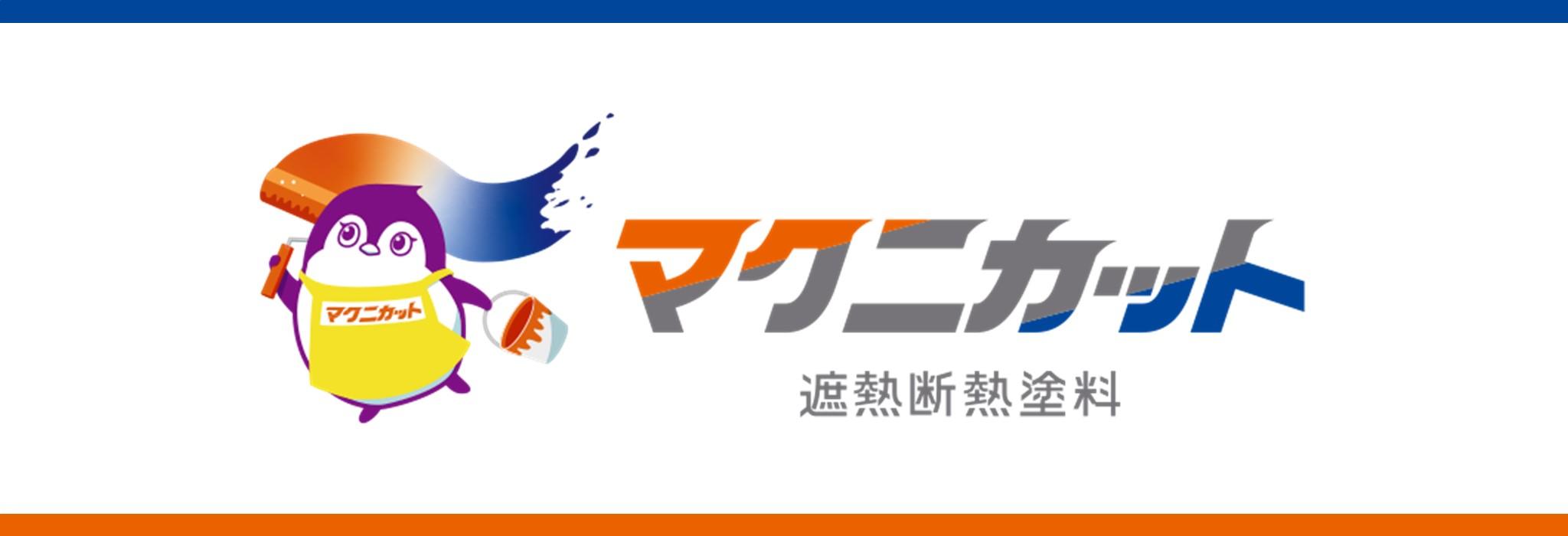
Reduce power consumption of outdoor air conditioner units as an energy-saving and power-saving measure for facility air conditioning
Reduce annual power consumption by 10 to 15%!
Reducing the power consumption of air conditioning is the key to saving energy and electricity
In recent years, electricity prices have risen year by year due to a shortage of domestic power supply and soaring prices of natural gas (LNG: Liquefied Natural Gas) and coal, which are used as fuel for thermal power generation.
According to the Agency for Natural Resources and Energy of the Ministry of Economy, Trade and Industry, air conditioning accounts for about 49% of power consumption in office buildings, about 37% in schools, and about 35% in medical institutions in the summer. (*1) In addition, the breakdown of power consumption in winter is about 34% for office buildings, about 41% for schools, and about 35% for medical institutions. ), reducing the power consumption of air conditioning is the key to saving energy and power in companies and facilities.
*1: Agency for Natural Resources and Energy, Ministry of Economy, Trade and Industry|Summer Energy Conservation/Electricity Saving Menu Leaflet Business Menu (Honshu/Shikoku/Kyushu version)
*2: Agency for Natural Resources and Energy, Ministry of Economy, Trade and Industry | Winter energy saving and power saving menu leaflet Business menu (Honshu/Shikoku/Kyushu version)
What can be done to reduce the power consumption of the air conditioner?
One possible method is to upgrade the air conditioning equipment to a product with a high energy-saving effect. Power consumption can be reduced.
Here, we will introduce heat-shielding and insulating paints that are effective in saving energy for outdoor units of air conditioners.
"Macnicut" is a heat-insulating paint that reduces the power consumption of outdoor units
By Macnicut heat insulating paint to the exterior of the outdoor unit, installing an energy saving cover, and applying heat insulating paint to the surrounding floor, the outdoor unit is kept in a suitable operating condition, reducing annual power consumption by approximately 10 to 15%, achieving energy saving and power saving in air conditioning. It is effective not only in summer but also in winter.
In addition to painting outdoor units, it is also used to paint exterior walls of buildings (roofs, walls, balconies, etc.) and to prevent heat damage to cubicles.
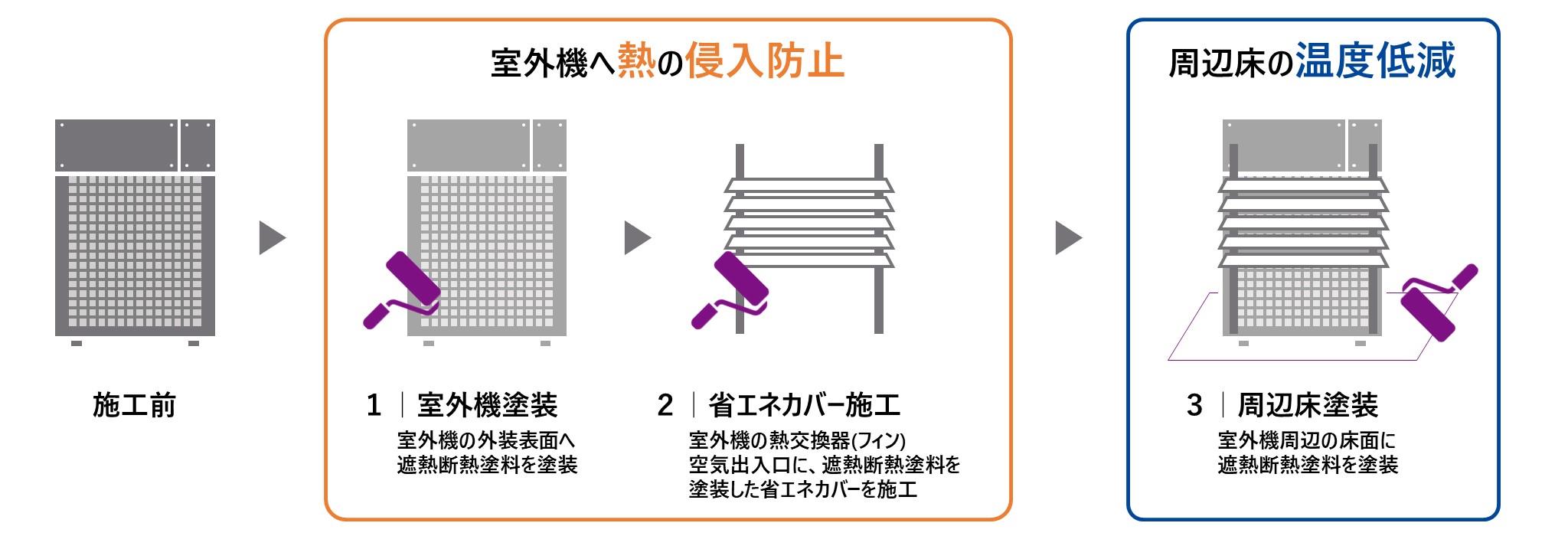
Energy-saving effect of heat-insulating paint "Macnicut"
Summer | Suppresses temperature rise inside the outdoor unit
■ Applying heat-shielding and insulating paint to the exterior of the outdoor unit and installing an energy-saving cover suppresses the temperature rise inside the equipment.
■ Furthermore, radiant heat is reduced by coating the floor surface around the outdoor unit with a thermal insulation paint, which lowers the ambient temperature. This lowers the temperature of the outside air taken in by the outdoor unit, reducing the amount of work done by the outdoor unit and reducing power consumption.
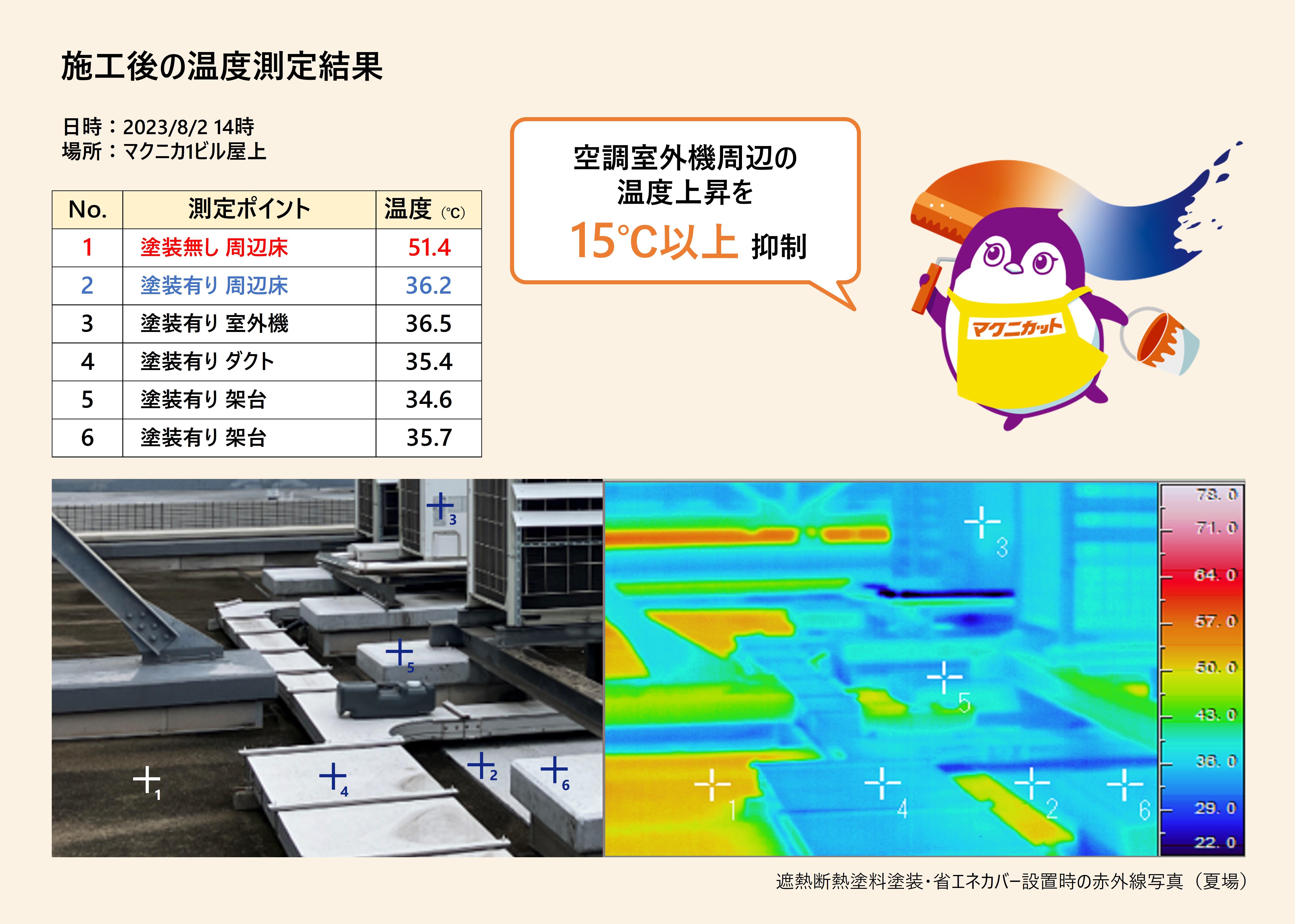
Winter | Prevention of temperature drop inside the outdoor unit and prevention of frost on the outdoor unit
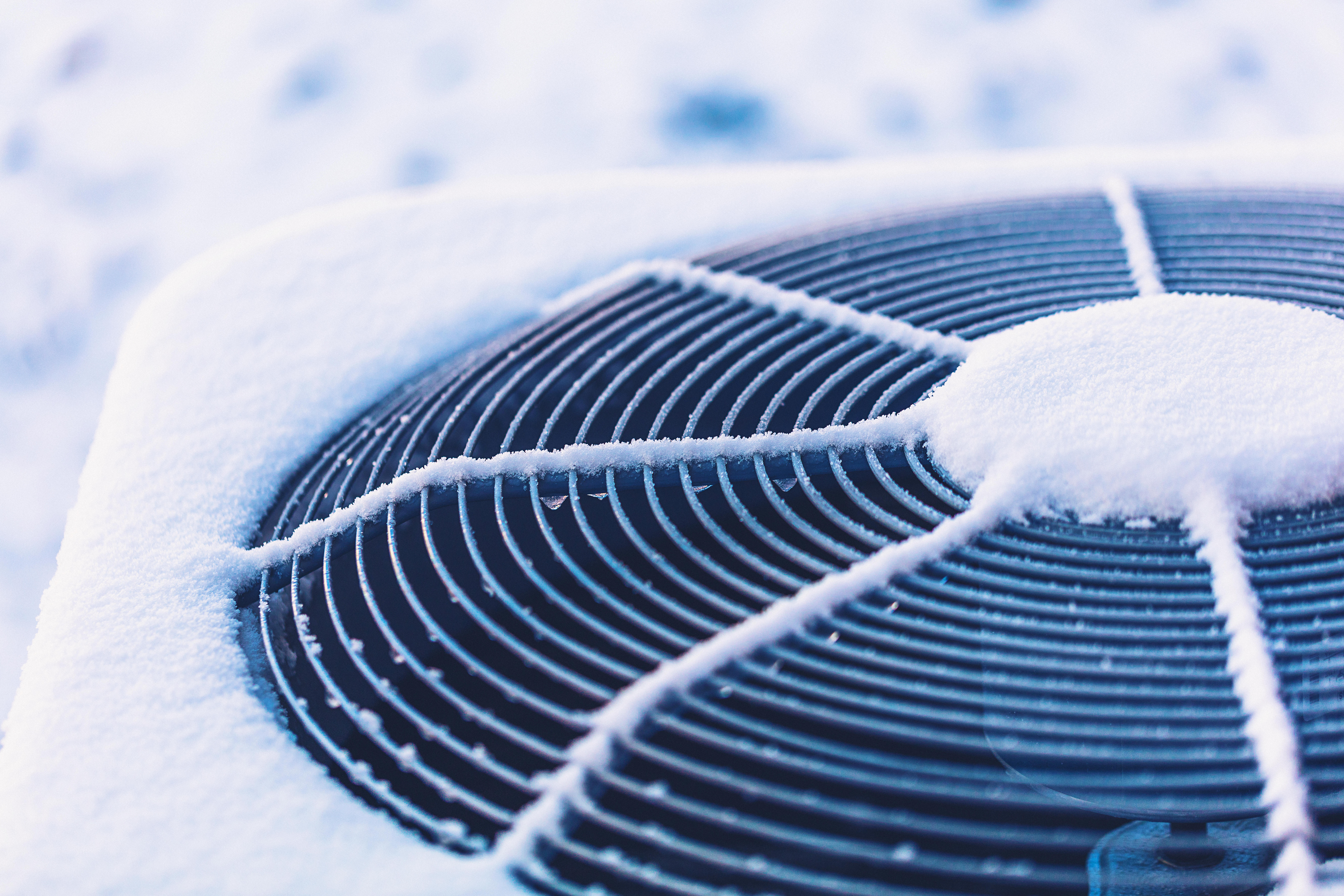
■ The heat-insulating effect of the heat-insulating paint applied to the energy-saving cover prevents the temperature inside the outdoor unit from dropping.
■ The energy-saving cover prevents frost from forming on the fins of the outdoor unit. When frost forms on the fins of the outdoor unit, the air conditioner's operating efficiency decreases, so the outdoor unit temporarily stops heating and starts defrosting operation (defrost). A lot of electricity is consumed when the heating is turned on again. By reducing the frequency of defrosting operation, power consumption in winter can be reduced.
■ Furthermore, we prevent temperature drop by painting on neighboring floors.
Features and functions of heat insulating paint "Macnicut"
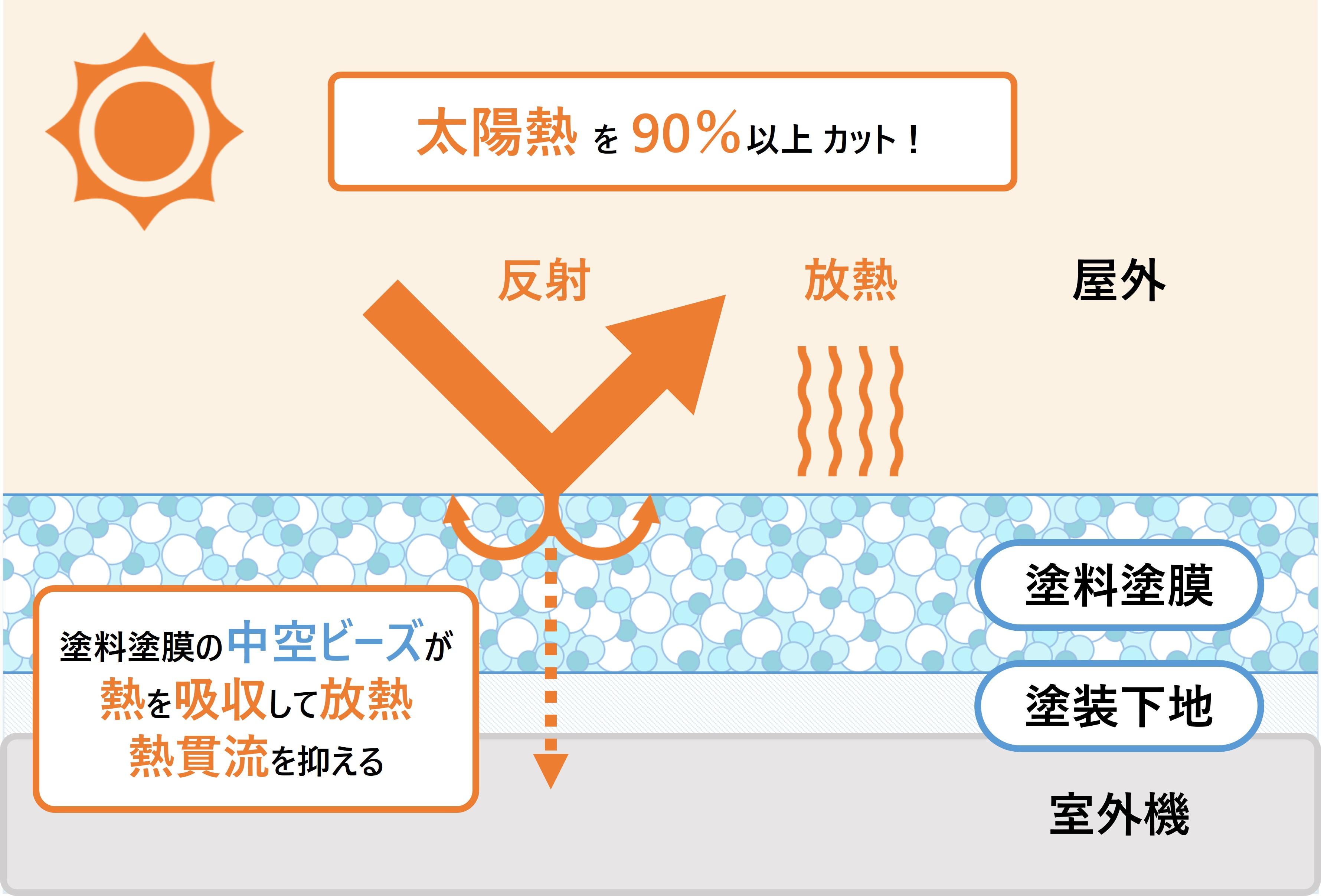
Heat shielding (reflection) function
The heat-shielding function of the paint reflects more than 90% of the solar energy, suppressing heat from penetrating inside.
Insulation function
Heat is prevented from entering because the hollow bead layer is evenly coated in a honeycomb pattern.
Telescopic function
Because it is flexible and follows 200% elongation, it prevents cracks on the painted surface.
Frequently Asked Questions
| question | Answer |
|
What is the heat resistance temperature of the paint? |
The heat-resistant temperature of the thermal insulation paint is 80℃. |
|
What is the recommended working temperature? |
The recommended working temperature is 5°C. In order to prevent the coating film from freezing when it is spread, the temperature must not fall below 5°C during the coating and for about 3 hours afterward. |
| What is the wind speed resistance of the energy-saving cover? | We have verified that there is no problem by assuming a wind speed of 39.8m/s. In addition, it has been verified for snow load and 10-year weather resistance. |
| What happens to the paint when it reaches the end of its life? | As with general paint, thermal insulation paint also hardens with age. After about 15 years, the paint hardens and cracks or peels off, so repainting is recommended. |
| When painting the floor around the outdoor unit, how wide should it be painted? | Basically, the height and width should be about 1.5 times the height of the outdoor unit, but it will be determined depending on the site conditions. |
| Is it effective when there is hail? | The weakest part of the outdoor unit is the fins (heat exchanger). If hail hits here, it will bend and the efficiency of air conditioning will decrease. Hail damage can be prevented by attaching an energy-saving cover. |
| Where are they used? | It is constructed and installed in commercial buildings, school facilities, factories, home centers, and other rooftop outdoor units and road surface outdoor units. In addition, as a heat shielding measure (thermal failure countermeasure), the number of construction results for cubicles such as railway communication equipment, communication bases, server rooms, etc. has increased in recent years. Previous cubicles were often designed with an outside temperature of 40°C as the upper limit, and in regions where temperatures exceed 40°C due to recent global warming, errors and failures due to high temperatures occur. |
Inquiry
You can also visit the actual air conditioner outdoor unit that has been painted with the heat insulating paint Macnicut. Please feel free to contact us for a quote or detailed specifications.
*Currently, the Company is the only company responsible for the application of the heat insulating paint Macnicut.
